Students can use Maths Mela Class 3 Solutions Chapter 2 Toy Joy Question Answer to explore alternative problem-solving methods.
Class 3 Maths Chapter 2 Toy Joy Question Answer Solutions
Toy Joy Class 3 Maths Question Answer
Class 3 Maths Chapter 2 Solutions
Some children are making animal and bird faces on old boxes, cans and paper.

Let us Do

Use old boxes (cubes and cuboids) and bottles (cylinders) to do craft work. Draw faces on them.
What did you draw on their faces?
- Jaya is building a rocket with her shapes. What shapes has she used?
- How many of each?
Cube: ______ Cuboid: _____
Cone: ____ Cylinder: ______

- What shape is between the red cuboid and yellow cuboid?
- What shape is on the top of the orange cylinder?
- What shape is under the pink cone?

Answer:
- Jaya has used cylinder, cuboid, cube and cylinder.
- Number of each shape used are
Cube — 2
Cuboid — 4
Cone — 1
Cylinder — 1
- The shape between the red cuboid and yellow cuboid is a blue cuboid.
- The shape on the top of the orange cylinder is cube.
- The shape under the pink cone is cube.
Collect objects to make a house. Name the shapes and talk about their faces and edges. Which are straight and which are curved? Also describe how the shapes have been arranged. What part of the shapes can you see from a distance?

Devika went to a shop and bought a toy engine.
Here is Devika’s toy engine. It has many parts. Count and fill.
______ red cylinder(s) ______ yellow cone(s)
_____ grey cuboid(s) _____ blue cube(s)
Answer:
Count and Fill (Devika’s toy Engine)
1 Red cylinder
2 Yellow cone
1 Grey cuboid
1 Blue cube
![]()
Let us Discuss
Here are some more toys from the toy shop. They are made up of different shapes.
What shapes are used in these toys?

Jaya made some houses using different shapes.
Answer:
Shapes used in toys:
- Cone and Cylinder
- Sphere and Cylinder
- Cone, Sphere and Cylinder
- Cube and Cuboid
Try to build such houses, towers, rockets, etc. using different shapes available around you.

Note that a cube is a special type of cuboid.
Answer:
Do yourself
Let us Play
Construct and describe
Ask students to sit in groups of four or five. In each group one student selects any three shapes and puts them together. The student, then describes the sequence of construction and the other students have to build the same without seeing the original one. Let children take turns and play the game in the group.

Example
The cylinder is on top of the cuboid. The cone is on top of the cylinder.
Let us Do
Question 1.
Can you find these shapes in the classroom? Fill in the table with their names.

a. Name the shape that you find the most. ________
b. Name the shape that you find the least. __________
c. Name the objects that are made up of more than one shape. ________
Answer:

Question 2.
Look at these shapes and answer the following questions.

• Circle ![]() the cubes.
the cubes.
• Put a tick ![]() against the shapes that are cones.
against the shapes that are cones.
• Put a cross ![]() against the shapes that are cylinders.
against the shapes that are cylinders.
• Put a box ![]() around the cuboids.
around the cuboids.
Answer:
• ![]() the cubes.
the cubes.
•![]() Cone Shapes.
Cone Shapes.
•![]() Cylinder Shapes
Cylinder Shapes
•![]() Around cuboids
Around cuboids
Question 3.
Name the shapes
• with no edges. ______
Answer:
Sphere
• with only flat faces. _____
Answer:
Cube and Cuboid
• with only curved faces. _____
Answer:
Sphere
• with both straight and curved edges. _____
Answer:
None
• with both flat and curved faces. _____
Answer:
Cone and Cylinder


Question 4.
Which shapes can you build?

Answer:
Do yourself.
Question 5.
Try to make these shapes using cubes

Answer:
Do yourself with the help of Teachers/Parents.
![]()
Let us Play
There is a game along the border of this page. Roll the die and move the counter to the next picture associated with the number on the die (if possible without crossing the “Finish” square) and play the game with your friends. The one who reaches the finish mark first wins the game.

Question 6.
In what ways are these shapes the same? In what ways are they different?

Answer:
There are 3-D shapes.
These shapes have different faces, edges and corners.
Question 7.
Look at a die. The faces have 1 to 6 dots. What number is on:
• the face opposite number 1? _____
• the face opposite number 2? _____

• the face opposite number 3? _____
• What pattern do you notice? _____
Answer:
• the face opposite number 1? 6
• the face opposite number 2? 5
• the face opposite number 3? 4
• The sum of opposite face number is seven.
Question 8.
In what order is this model built?


Answer:
This model built:
3 red cuboids are used for stairs.
2 small cuboids are used for base.
1 big cuboid is used for floor.
4 cylinders are used for pillars.
1 big cuboid is used for roof.
4 cones are used at the top of roof.
• Shape get by joining a cube and cuboid of same height is cuboid.
• Number of cubes used to make shape are:
9 cubes in first row
7 cubes in second row
5 cubes in third row
So total cubes = 9 + 7 + 5 = 21.
Question 9.
In how many different ways can you join 3 cubes? Try and see.

Answer:
Different ways to join 3 cubes.

![]()
Question 10.
Name the shapes used in these models. Describe how the shapes are arranged to make them.
Use six dice to make the following shapes:

Answer:
The shapes used in the models are cuboid.
Question 11.
Use six dice ![]() to make the following shapes:
to make the following shapes:
(a) A Cuboid
(b) A tower
(c) Any other shape of your choice
Answer:
Shapes making using 6 dice:
(a)

(b)

(c)
Do yourself
NCERT Solutions for Class 3 Mathematics Chapter 2 Fun With Numbers (Old Syllabus)
1.Radhika, Gauri, Vicky, Indra and Sunil were collecting Imli (tamarind) seeds. Let us see how many seeds were collected by them.
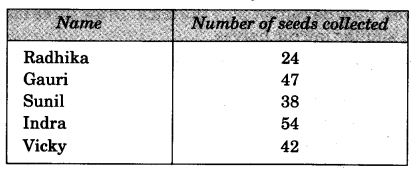
Fill in the blanks:
(a)————- collected the most seeds.
(b) Sunil will collect————-more seeds to be equal to Vicky.
(c)If Radhika gets 6 more seeds, she will have————-
(d) How. many children have more than 40 seeds?————-
(e)————- needs 3 more seeds to have 50.
(f) Sunil has 2 seeds less than 40 and————-has 2 seeds more than 40.
Ans. (a) Indra (b) 4 (c) 30 seeds (d) 3 (e) Gauri (f) Vicky.
Dhoni’s Century
1.Dhoni scored 96 +———– = runs
Ans. 96 + 6 = 102
2.How many runs do these players need to complete a century?

Ans. Player 1; 100 – 93 = 7 Player 2; 100 – 97 = 3
Player 3; 100 – 89 = 11 Player 4; 100 – 99 = 1
3.Fill in the blanks:
Ans.
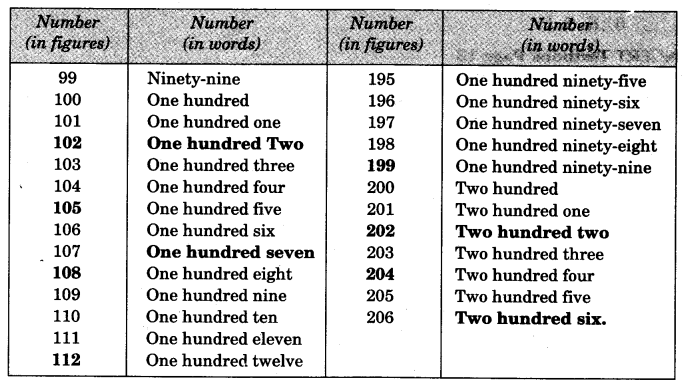
4.Oh! 206! Guess how many more to make a triple century?
Ans. Triple century = 300
So, 300 – 206 = 94
Top Tea Scores in the Cricket World Cup
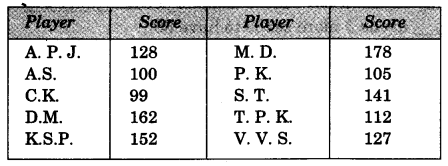
1.Fill in the blanks:
1.C. K just missed his century. How many runs did he need to make a century?————
2.————and———— scored almost equal runs.
3.————scored a complete century, no less, no more.
4. Most runs scored by any batsman are ————
5.————and———— have a difference of just 1 run between them.
6. ————scored 2 more runs than one and a half-century.
Ans. 1. 100 -9 = 1 Hence C. K. missed his century by 1 run.
2. A. S. and C. K. or A. P. J. and V. V. S.
3. A. S.
4. 178 scored by M. D.
5. A. S. and C. K. or A. P. J. and V. V. S.
6. K S. P.
2.Fill in the blanks (Counting in 10’s)
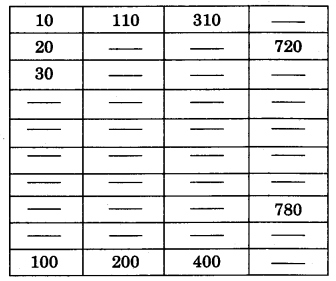
Ans.
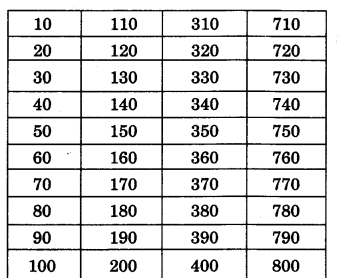
3.Fill in the blanks (Counting in 50’s)
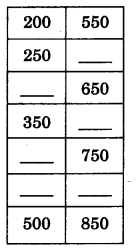
Ans.
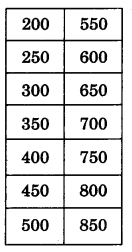
4.How For can you go like this?
Ans. We can go on and on, because there is no end to these numbers.
5.What is the biggest number you can call out?
Ans. There is no biggest number and hence we cannot call that number.
Colour the Numbers
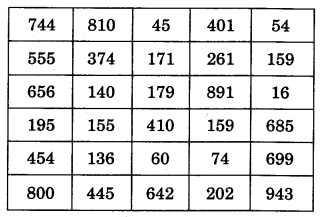
1.Find these numbers in the above chart and colour them.

Ans.
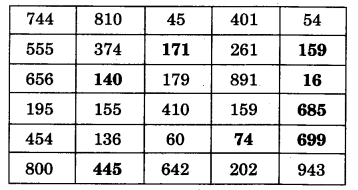
Jumping Animals
Find out:
(а)Gabru and Bunny both jump on squares 104,————— and—————
(b)Tarru and Bunny both jump on squares,—————,————— ,
—————and —————
(c)Is there any square where all three of them jump?—————
(d)Guess who will finish in the least jumps?————— In how many jumps?
Ans. (a) 139 and 174 (b) 114, 134, 154 and 174 (c) 174 (d) Gabru, 12
Hint: The last square is numbered 175. Multiply number of square in one jump by number of jumps for an animal. Add the result with the number on starting ; ‘square. You can also take Ludo coins of different colours to count the number of squares for an animal.
Class, Jump!
(a) Jump 2 steps forward:
104,106, 108,————- ,————- ,————- ,————-
(b)Jump 2 steps backward:
262, 260, 258,————- ,————- ,————- ,————-
(c)Jump 10 steps forward:
110,120,130,————- ,————- ,————- ,————-
(d) Jump 10 steps backward:
200,190,180,————- ,————- ,————- ,————-
Continue the pattern:
(e)550, 560, 570,————- ,————- ,————- ,————-
(f) 910,920,930,940, ————- ,————- ,————- ,————-
(g)209, 207, 205,————- ,————- ,————- ,————-
(h)401, 402, 403,————- ,————- ,————- ,————-
Ans. (a)110, 112, 114, 116
(b) 256, 254, 252, 250
(c)140, 150,160, 170
(d) 170,160, 150, 140
(e)580,590,600,610
(f) 950, 960, 970, 980
(g) 203, 201,199, 197
(h)404,405,406,407
Lazy Crazy Shop
1.Find out how many packets of tens, hundreds and loose items each animal will take. Fill in the blanks:

Ans.

2.Lazy Crazy also has a crazy way of taking money. He takes only in ?.100 notes, ? 10 notes and coins. Now find out how they will play him for what they have taken.
1.Rs 420 2.Rs 143 3.Rs 242 4. Rs 55
Ans.1.Rs 420 4 Rs 100 notes and 2 Rs 10 notes.
2.Rs 143 1 Rs 100 notes, 4 Rs 10 notes and 3 Re 1 coins.
3.Rs 242 2 Rs 100 notes, 4 Rs 10 notes and 2 Re 1 coins.
4.Rs 55 5 Rs 10 notes and 5 Re 1 coins.
3.Who am I? Match with the number.

Ans. 1. 45 2. 89 3. 96 4. 100 5. 150 6. 87
4.How many are these?
Ans. (a) 240 rupees (b) 319 sticks (c) 212 blocks (d) 138 beads (e) 320 rupees.
Moon Mama Counts His Starry Friends
1.Which cards will I have in my pocket if I have counted up to
(а)19 (b)21 (c) 95 (d)201 (e) 260
(f) 300 (g) 306 (h) 344 (i) 350 (j) 400
Ans. (a) T9 [10] [1] [1] [1] [1] [1] [1] [1] [1] [1]
(b)21 [10] [10] [1]
(c)95 [10] [10] [10] [10] [10] [10] [10] [10] [10] [1] [1] [1] [1] [1]
(d) 201 [100] [100] [1]
(e) 260 [100] [100] [10] [10] [10] [10] [10] [10]
(f) 300 [100] [100] [100]
(g)306 [100] [100] [100] [1] [1] [1] [1] [1] [1]
(h)344 [100] [100] [100] [10] [10] [10] [10] [1] [1] [1] [1]
(i)350 [100] [100] [100] [10] [10] [10] [10] [10]
(j) 400 [100] [100] [100] [100]
2.When I had [10] [10] cards in my pocket, I knew I had counted 20 stars. Now you tell me the number of stars counted in each case. Write the answer in the blank space.
Ans. (a) [10] [10]. —————–20
(b)[10]'[10] 1 11111 . —————–26
(c)[100] [100] [10] [100] —————–310
(d)[100] [10] [10] [10] .—————–130
(e)[100] [100] [100] [100].—————–400
(f)[100] 1 1 [100] 1 1[10] 1 1 [100].—————–316
(g)[100] 1 [100] [100] 1 [100] [100] 1 [100].—————–603
(h)[100] [10] [100] 1 [100] [10] [100] [10].—————–431
(i)[100] [100] [100] [100] [100] [100] [100] [100] [100] [100].—————–1000
3.Guess how many starry friends I have in all……..!!!
Ans. These are 38 in numbers.